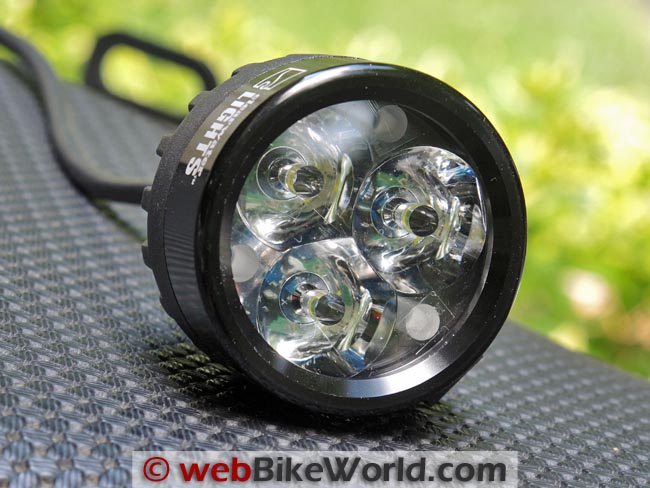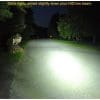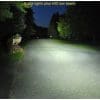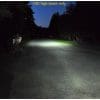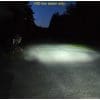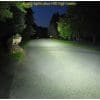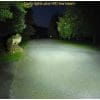Clearwater “Darla” LED Lights Review
The high-quality Clearwater Darla light kit is indicative of the latest in LED technology and also reflects the best of what Clearwater Lights brings to motorcyclists.
The Darla lights have nearly the same perceived brightness as the more powerful Clearwater Krista Lights (review) but with the small form factor of the Clearwater Glenda lights (review).
The Darla lights use a rotating dimmer switch to quickly adjust the lights from full power (2,000 lumens each) down to 100 lumens (5% of total output) to meet changing lighting needs.
This capability also contributes positively to maintaining a safe riding environment by using the lights as DRLs.
The Darla LED lights can also be wired to turn on at full output when the motorcycle’s high beam is engaged.
This is a combination that leaves little doubt as to their effectiveness and adds to the width of the beam at the sides for safety at night.
High power is definitely not for use on active roads with other vehicles however; sharing the road safely is paramount.
Small but mighty, the output from the Clearwater Darla LED lights is optimized for consumption efficiency.
The lens pattern provides effective light projection patterns for both near, far and changing terrain conditions, with blind or weak spots virtually eliminated.
By slightly modifying the mounting position and aiming, a variety of beam patterns can be achieved.
Whether a first-time user or experienced installer, the Clearwater light kits are complete in every way and the detailed instructions make getting the Darla LEDs up and running a satisfying task.
Some motorcyclists may feel that these lights are expensive, but their design and the made in the U.S.A. construction, along with high-quality components and functionality make these lights well worth the investment.
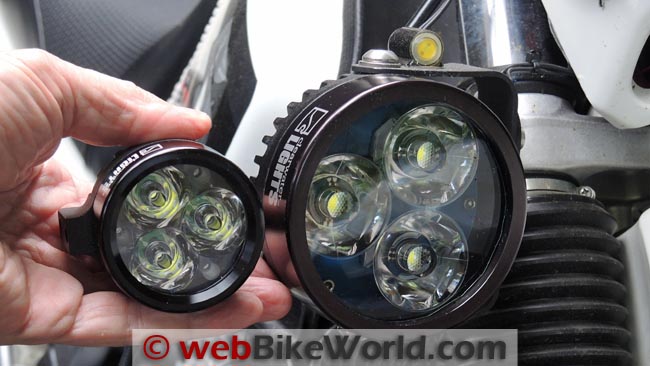
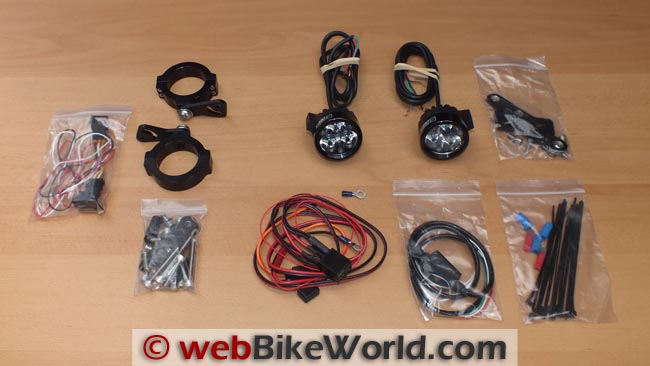
Where to Buy Clearwater Darla Lights
Check Reviews & Prices on Amazon Check Reviews & Prices On RevZillaAlso Shop for: LED Lights and Bulbs, Auxiliary Driving Lights, Motorcycle LED Headlights
Background
Based on the feedback from the webBikeWorld Cylcops Adventure Sports Optimus LED Prime review and after doing some research on current motorcycle LED lighting technology, we thought it would be good to weave in some follow-up information from that review and also to the facts presented in the Clearwater Krista Lights review.
As Rick and Burn said in that review, “We’ve witnessed an incredible evolution of the (LED) technology” and the revolution in lighting, continues.
Just witness the ever-growing and ever-more sophisticated application of LED technology in virtually everything lighting related recently.
As output ratings for motorcycle and powersports LED systems (typically measured or listed in lumens) head for the sky, there is no doubt that the way ahead is going to be much (much) brighter.
But unless the technology and output is managed to some degree, many of the positives may actually become negatives, with safety and legislation (laws) coming to mind.
In our desire to see more of the unfolding way ahead we apply natural abilities, experience, knowledge and training to let us see and visualize the road ahead; the further you look down the road and the further you think down the road increases the fun and safety — both on or off the road.
With many of us riding well into or through the night, coping with the “dark side” becomes paramount.
We can still visualize the road ahead to degrees, but we don’t have the same natural ability to actually see it — and don’t forget all those other factors, like fatigue.
High output lighting solutions — including LEDs — when paired with related technologies like adaptive, active and self-leveling headlight systems to name just a few, are providing some innovative but (still) slightly expensive solutions.
Another positive being wrung from all this synergy is that lighting output and related safety concerns are being addressed more actively within industry and our riding community.
One good example of how LED and related technologies are being utilized is the full LED lighting solution now available for the new BMW R 1200 GS “Water Boxer”; a timely example of what is to come.
LED lighting, along with engineering and design validation through extensive testing, makes our motorcycling world much brighter and safer.
And getting to the point, prime examples of how to apply the technologies for better lighting, visibility and safety are the new Darla and (soon) Erica LED lights from Clearwater.
The Clearwater LED Light Lineup
So despite having to wait a bit longer before getting a look at a set of the ultra-high output (6,000 lumens each) Clearwater Erica lights, we have a set of the brand-new Clearwater Darla LED lights — coincidentally just in time to install and use on a trip south.
With the Clearwater Glenda lights (review) and now the Darla lights as the Clearwater DRL/driving light solution and the Clearwater Krista LED lights (review) and the Erica lights (review) for maximum long-distance night riding, Clearwater has a well-rounded product line.
First comes the the 12 Watt, 800 lumen (each) Clearwater Glenda lights in the current Clearwater lineup.
Next are the Darla lights described here, with 2,000 lumens (each) and 20 Watts (each) rated output.
The Glenda lights are biased towards visibility or Daytime Running Light output with a wide beam pattern for side marking visibility at night.
The Darla lights described here are a step above the Glenda lights in terms of output, yet on a dark night, their output seems closer to the more powerful Krista lights (although the Krista lights have a bit more distance “throw”).
The Darla lights can also be used as DRLs when turned down to their lowest setting of 5% or 100 lumens output, yet they provide excellent side width in the beam pattern and a good distance pattern as well.
The very powerful Clearwater Krista lights at 36 Watts and 2,400 lumens output (each) may be too much for some smaller bikes, with both their size and power requirements considered.
With their on/off switch in addition to the rotary dimmer dial, the Krista lights are designed to be used at night on otherwise unoccupied roads or when riding off-road only.
Both the Krista and Darla lights are so bright on the high setting, however, that extreme caution is advised to make sure the lights are aimed correctly and dimmed at night when any oncoming traffic or pedestrians are about.
If the Krista LED lights are ultra-powerful — and they are — then the upcoming Clearwater Erica LED lights, at 60 Watts and 6,000 lumens each, will probably melt the pavement 100 meters out.
The Erica lights will occupy the top-of-the-line ultra-LED output and we hope to have a set soon for a review.
Clearwater Darla Light Specifications
Our experience has shown that the Clearwater lights are built with the principles of excellent design.
They have industry-leading features, simple standardized harnesses and a variable output capability — the latter addressing issues near and dear to all of us, like maintaining a safe environment for all road users.
The Clearwater Darla lights reflect (pun) these principles in every way.
Using the same two inch diameter CNC machined housing found on the Glenda LEDs we reviewed in 2009, the new variable-power Darla lights now pack in excess of 2,000 lumens of peak output each.
They also have excellent power efficiency, consuming only 24W of power per unit at their highest setting.
These specifications compare favourably to the original Glenda lights, which are rated at 800 lumens each (on high) and 12W per unit.
Thus, the Darla lights are brighter than the Glena LEDs by a factor of two, giving them a bit more “attitude”; an apt description to say the least and totally validated during use.
The beam pattern of the Darla LED lights is similar to other Clearwater lights.
This equates to 85% of the light output pattern spread in a 15-degree (spot light type) cone pattern and 15% in a 45-degree (wide or fog light type) pattern for side-to-side projection; important when riding a motorcycle at night.
The light is projected in a near-field surrounding halo of white for horizontal and vertical coverage, something that really helps in coping with changing terrain features, both near and far.
But in fact, the Darla lights output is closer to the more powerful Krista lights than to the Glenda. See the photo slide show below for a comparison of the Darla and Krista light patterns.
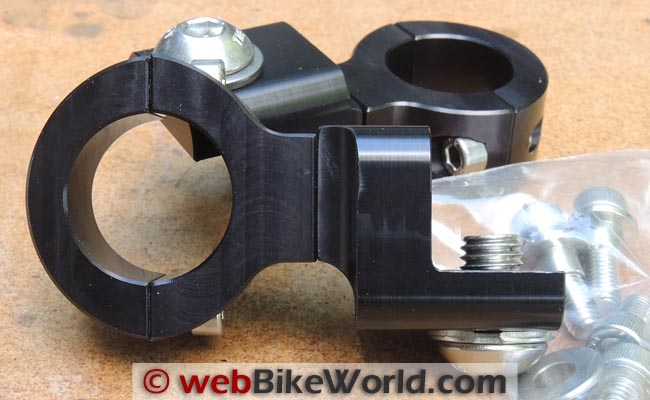
The Clearwater Darla LED Light Kit
Clearwater Lights has specific fitment kits for “standard” and “off-road” applications for their lights, so the kit contents will vary, depending on the configuration you order.
Our Darla light kit consisted of two Darla LED Modules, two “universal” mounting brackets, the dimmer control switch with wiring harness, a miniature relay, Posi-Lock, Posi-Twist and Posi-Tappieces and zip ties.
Also included are instructions with configuration and connectivity photos and diagrams (here are the Clearwater Lights installation manuals for various bikes).
The Off-Road Kit includes two universal brackets (66 mm long), two long universal brackets (100 mm), two machined clamp brackets (50 mm inside diameter) for mounting to crash bars and one headlight jumper harness.
Darla (and other Clearwater Lights) lights are available with mount kits for BMW, Buell, Harley-Davidson, Honda, Suzuki, Triumph, Victory, Yamaha and others. A generic mounting kit is also available.
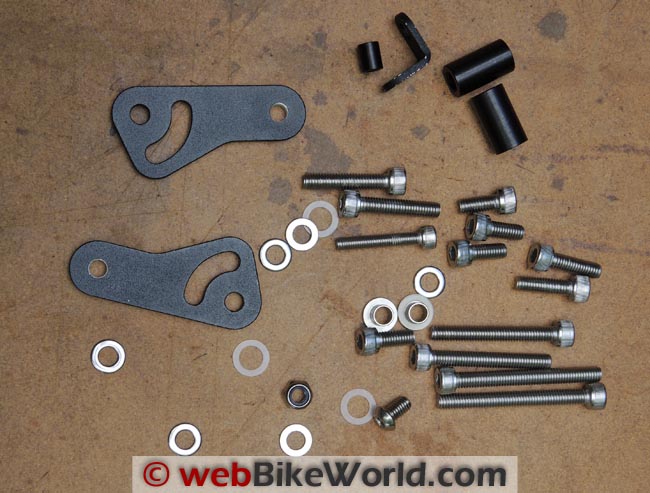
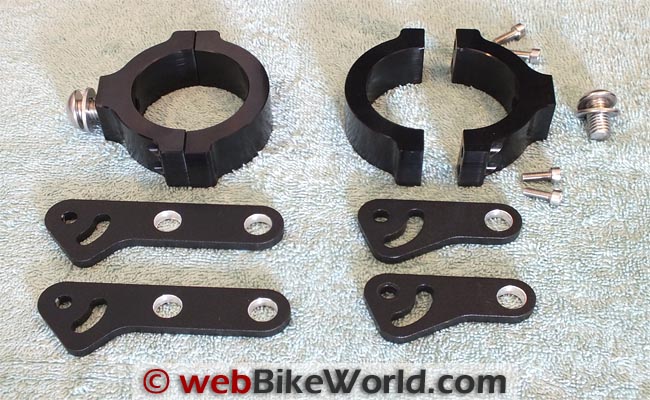
MMounting the Clearwater Darla LED Lights
I had originally intended to install the Darla LED lights on my BMW R 1200 GS, but once again another opportunity presented itself.
The newest member of my home fleet, a 2014 BMW F 800 GS Adventure, arrived about the same time as the lights.
So in preparation for its first trip to the BMW RA Rally in Asheville, North Carolina, it only seemed right to install the Clearwater Darla lights on the Adventure, providing an early evaluation opportunity and auxiliary lighting for the trip.
In reality, this worked out well.
Installing the Clearwater kit on the new Adventure and then on the R 1200 GS paralleled the installation of the Cyclops LED light kit.
So the installations were an excellent opportunity to see and reflect upon the differences between the systems, with the most obvious being the size and complexity of harness components.
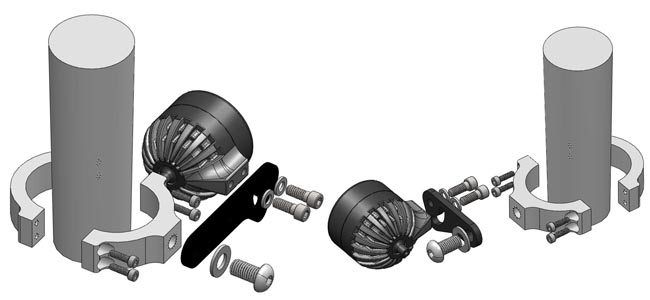
Where to Buy Clearwater Darla Lights
Check Reviews & Prices on Amazon Check Reviews & Prices On RevZillaAlso Shop for: LED Lights and Bulbs, Auxiliary Driving Lights, Motorcycle LED Headlights
Sample Installation: BMW F 800 GS
AAs an example installation, this time on the 2014 BMW F 800 GS Adventure, I used “Option B” by mounting the machined Clearwater Darla light brackets on the engine guards.
This lower positioning was just fine anyway, letting me evaluate the effectiveness of the lights when mounted low and also increasing the lighting visibility triangle (LVT) from the front.
Note that some may argue that having the lights well below the front fender line diminishes the value of these lights as DRLs, especially when following in heavy traffic.
Since the F 800 GS already has brackets on the front left and right edges of the original equipment BMW engine guards (a Launch Edition freebie), I had the needed platform for mounting the lights.
That was a single M6 x 16 mm stainless steel screw and flat washers combination did the trick in securing the modules in place.
The Clearwater-supplied generic clamp style brackets for round tubing are heavy duty and readily adjustable via Allen-head screws for horizontal and vertical positioning and aiming of the lights.
In swapping out the Denali D1 lights (review) for the Clearwater Darla lights, the difference in weight became very noticeable. Granted however, the Denali housings are among the toughest I have ever seen, or used.
The Clearwater Darla light modules have long harness leads (a least a metre long), with three wires encapsulated in a thick rubber housing.
Given this length it was a simple matter, once the small rear sections of the side cowlings were removed, to run the harnesses up and into the battery box area — home of many things electrical on the F800GS.
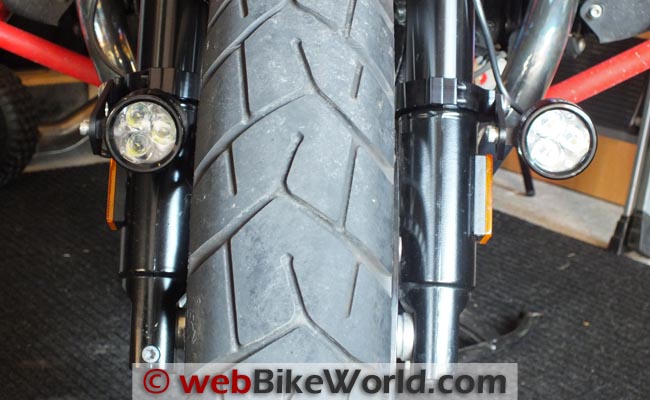
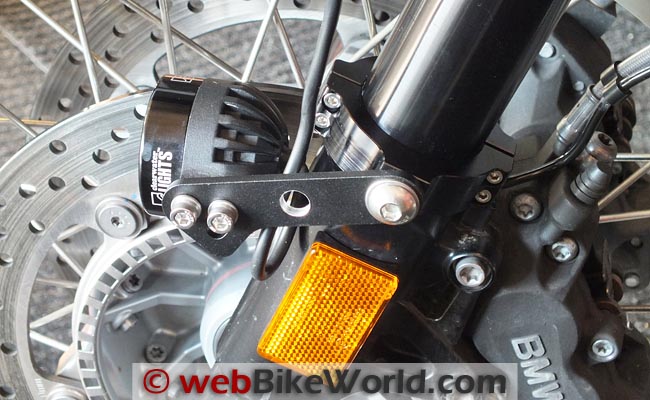
The Clearwater Darla Lights Dimmer Control
Clearwater was one of the first (if not the first) LED light manufacturer to incorporate a dimmer control or rheostat into their light systems.
Prior to that, LED lights were either on or off only.
I mounted the small L-shaped bracket for the Clearwater dimmer switch rotary know on to the side of the switch housing.
Then I inserted the side of the bracket under the heavy rubber sleeve on the left mirror of the BMW and used a small tie strap to keep both in place.
This placement is similar to that used by Rick for the Clearwater Krista lights (review), mounted on the Suzuki DR650 (blog). The switch didn’t budge during the almost 4,000 kilometer trip.
Relay Placement
With the wiring harness from the Clearwater Darla lights dimmer control fed back to the battery box area and the LED harnesses at hand, the final wiring could be completed.
The diminutive relay provided by Clearwater is a joy to work with.
Also, the “right-sized” wiring provided is also excellent, especially when comparing it to the rather large (but effective) harness used for the Cyclops lights.
Following the detailed instructions provided with the Clearwater kit, I had the colour coded wires twisted together and secured inside provided Posi-Twist pieces.
A Posi-Tap on the green/blue wire of the BMW’s diagnostic plug provided the needed 12V DC+ trigger for the lights.
And that connection was made via the red wire from the Clearwater relay.
With all the connections made and a test successfully conducted, it was just a matter of bundling up leads and doing some housekeeping, even though the installation was temporary.
Everything fits neatly into the space between the battery and the front of the airbox housing on the BMW.
Like the Clearwater Glenda lights, the Darla lights are designed to be on all the time.
Neither system has an on/off switch, but when the rotary dial is turned all the way down, the lights stay on at 5% of their total output for both day and night time visibility.
The Darla lights were also installed on my 2012 BMW R 1200 GS Rallye.
The fork tubes on this bike are tapered (top and bottom sections), so the Clearwater clamp mounts only work at specific points.
These are at the bottom of the lower section and a bit higher than the axle.
Alternatively, they could also be mounted higher on the upper fork section.
The fork clamps are mounted with four M4 x 12 mm screws.
I also lined up the front halves with the casting line on the lower leg assembly, but later adjusted them to provide some offset from centre, basically widening the light output coverage.
Note that when installing the left clamp on the R 1200 GS, make sure the halves clear the (thin) ABS sensor lead (black shiny plastic coated) that runs in just below where the bottom edge of the clamp will be.
Locating the Darla Lights for Optimal Output
If you want a wider lighting output triangle in front of the bike, the side or outside orientation works using the short Clearwater brackets.
But if protecting the light modules is more important, using the longer brackets lets the modules sit immediately in front of each fork tube.
The different is about an 8.5 cm to 3 cm offset respectively from the fork legs.
For evaluation purposes, I mounted the Darla LED light modules both ways just to see how they looked and also to determine what the differences in light projection and coverage might be; not a whole lot as it turned out.
So with the clamps oriented 2 mm out from centre for a wider lighting perspective, I angled the brackets upwards about 45 degrees so the rear axis screw is basically centred for vertical adjustments.
The LED modules were set to horizontal for the first tests.
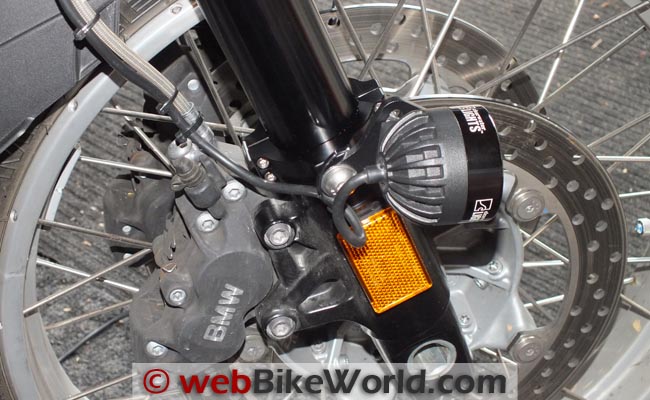
Aiming and Leveling
For initial orientation of the lights, I use a small portable leveling bubble and the “Waterlevel” app on the iPhone; it does yeoman service on things like this and when measured against other tools, does remarkably well.
The LED leads were given a drip-loop, run to the hydraulic brake lines and routed up those paths to the top of the fender then back to the right side of the frame, where the front sub-frame joins, leaving me about 25 cm of lead for connection purposes.
Sample Installation: BMW R 1200 GS
On the BMW R 1200 GS, I mounted the Darla lights rotary dimmer control to the inside screw of the left mirror bracket.
This is readily available to the left hand, but out of the way of everything including the side of the tank bag at full left lock.
The harness was run down the existing control wire bundle and across the back of the steering head to the right side sub-frame where the module leads were waiting.
The wiring harness for the R 1200 GS and GSA models lets the user connect the Clearwater lights to the OE headlight harness without splicing or tapping into existing wires, such as for the 12V DC+ trigger wire.
Installing this in-line harness is simple.
Unlock and remove the female wire-lock modular connector from the housing (lower right behind the high beam cover); plug the Clearwater female connector into the housing socket; and, plug the male connector of the Clearwater headlight harness into the disconnected OE female plug — done.
With main power supplied by the battery via the relay, the 12V DC+ trigger can be supplied by the single red wire off the headlight connection harness, rather than using another switched source, as done for the F 800 GS installation.
The single white wire goes to the white wire from the dimmer control harness and while the black wire isn’t needed and can be cut off or wrapped up, I recommend adding it to the common ground bundle, making for five wires easily twisted together inside one Posi-Twist.
NOTE: The Darla (and Krista) lights will only reach maximum power when they are connected to the high beam power wire and when the high beams are switched on. Tap into the high beam wire with the white wire in the relay bundle for the Darla lights, using a Posi-Tap.
The rotary dimmer switch dial will take a single Darla light from 100 lumens on the lowest setting to 1,100 lumens at the highest rotary dial dimmer switch setting (2,200 total for two lights), then up to 2,000 lumens each, or 4,000 lumens total for the two lights when the high beams are engaged.
With the white wire connected, starting the motorcycle activates the LEDs at whatever setting the rotary control is set to and when the high beam is activated, the LEDs automatically go to full output, as they do when the bike’s flash-to-pass switch is activated.
On low beam, the rotary dial for the Clearwater lights is fully functional allowing whatever output setting is desired for the way ahead, keeping in mind that common sense, courtesy and safety are absolutes in using any auxiliary lighting, particularly LED systems that are extremely bright and intense.
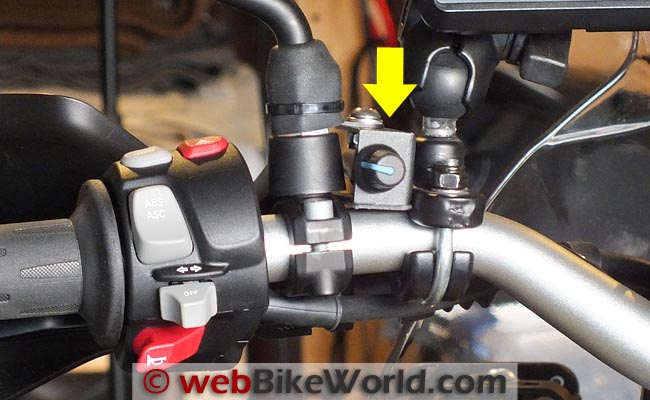
Where to Buy Clearwater Darla Lights
Check Reviews & Prices on Amazon Check Reviews & Prices On RevZillaAlso Shop for: LED Lights and Bulbs, Auxiliary Driving Lights, Motorcycle LED Headlights
Function and Performance
Before heading off, I did complete a quick aiming exercise.
This involves positioning the motorcycle about 8 meters (25 feet) away from the garage door, and measuring the height of the lights and making an equal mark on the door for leveling purposes. I then adjust the lights down so that the centre of the beam is two to three inches below level.
This setting isn’t optimal for distance projection, but it does reduce glare to oncoming or traffic ahead and provides good output for using the lights as DRLs for night-time augmentation.
On the lowest rotary dial setting of 5% output, the two Darla LEDs mounted on the forward edges of the F 800 GS Adventure engine guards provided an excellent conspicuity triangle with the headlight without being obtrusive in any way, a fact commented on by other riders.
As nighttime approaches or in light rain or fog, bringing the lights up by a quarter or half turn on the rotary dimmer control dial proves how quickly the Darla LEDs can be adapted on the fly to meet rapidly changing conditions, a big plus.
I did remember to make a note at the first rest stop about ordering a set of the Amber acrylic lenses (review) as a colour output option.
Also a set of the light covers to protect the lenses, as some states have specific guidelines and/or restrictions on the use of auxiliary lighting.
For my trip, the the bike’s high beam wasn’t wired into the harness, but even without having full output available, settings between Min and Max on the rotary that provide up to 50 percent of maximum output (about 1100 lumens).
This was more than enough for use as auxiliary lighting with the rotary providing quick dimming.
Back home, the lights were then transferred to the BMW R 1200 GS Rallye, with the LEDs mounted on the front forks using the clamp mounts and both sets of brackets, for front of fork placement or a wider stance as mounted away from the fork.
There is some minor difference in output coverage between the two placements.
But in reality, the more important factor is whether you want to better protect the LEDs by having them inboard and directly in front of the stanchions or hang them out in the breeze more.
Either way, some clear film or small wire guards to protect the lights are highly recommended; something not yet offered by Clearwater.
So for some longer term peace of mind, I took two ADVMonster LED plastic lens guards and trimmed 1 mm off the diameter of each, then peeled off the adhesive backing and stuck them in place over the Darla lenses for a perfect fit.
After two months of continuous use on two motorcycles with road and off-road time, the Clearwater Darla lights continue to provide excellent daytime running light service.
And when the sun sets, it is a simple matter to adjust the rotary dial to provide needed light augmentation, with full output instantly available on high beam.



NOTE: Slide show photos taken at ISO800, shutter speed of 1 second at f5.6
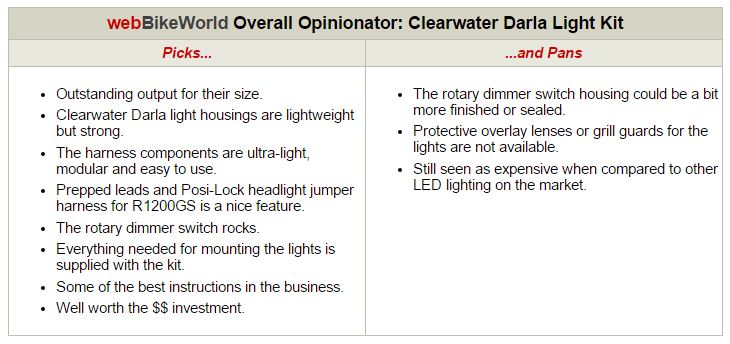
Conclusion
In re-reading the original Clearwater reviews on the Glenda and Krista LED lights and reviewing some other evaluations and postings regarding the Clearwater products, it is obvious that the company has continued to refine and enhance both their mounting and wiring components.
From my perspective, the Clearwater kits are among, if not the best, on the market.
The in-line headlight jumper harness for the BMW R 1200 GS is a good example of how to make life easier for a user in simplifying overall installation and enhancing system performance.
My installations were far simpler and easier than Rick and “Burn” experienced with the original Clearwater LED lights, the Glenda LED lights (review) way back in 2009.
Another positive: Clearwater sent an upgraded gasket set for the Darla lights, along with detailed instructions on how to get the replacement O-rings installed right the first time. You have to like attention to detail and service like that.
The upgraded O-rings will be included on all new Darla lights in production.
Functionally, being able to run the LEDs at minimal output (5% of total or about 100 lumens) or slightly higher as Daytime Running Lights or visibility lights, and then effortlessly bringing them up to a higher setting via the rotary dimmer dial is a real advantage over fixed or switched output systems.
This is smart light management we can all live with.
I was once one of many motorcycle owners who wanted to use the Clearwater lights but the price kept me from diving in.
But no more; after installing and using the Darla lights, my personal cost concerns are laid to rest, because these are indeed worth the investment.
More wBW Clearwater Krista LED Lights Review | Motorcycle Lighting Reviews
Review Date: August 2013
Where to Buy Clearwater Darla Lights
Check Reviews & Prices on Amazon Check Reviews & Prices On RevZillaAlso Shop for: LED Lights and Bulbs, Auxiliary Driving Lights, Motorcycle LED Headlights
Owner Comments and Feedback
See details on submitting comments.
From “T.R.” (April 2017): “I installed a pair of the Clearwater Darla lights on my KTM 1190 Adventure. I was unaware that the Clearwater headlight harness would include actuating the Darlas via the KTM features.
Restated, the KTM Daytime Running Light mode dims the headlights in daylight and that completely turns off the auxiliary Darlas. I ride with my brights on during the day and the Darlas run full brightness.
However, in full daylight dimming the headlight will turn off the Darlas.
After sunset, the bike automatically turns the headlights back on and the Darlas light up according to the handlebar rotary dimmer setting.
Most importantly, the Clearwater dimmer is a Pulse Width Modulator and this generates a lot of Radio Frequency noise.
Before installing the auxiliary lights I was able to receive FM stations just about anywhere. Now I get really bad reception in locations that I used to receive just fine.
Finally, the security guards manning the gate at my job tell they see me coming from a mile off. Despite rows of cars waiting to be waved in, they see me.
The added visibility assures my daily 70 miles of Los Angeles lane splitting commute is the safest possible.”


